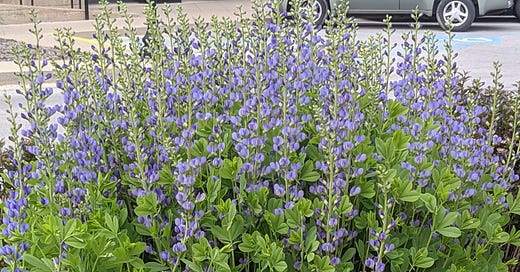Around these parts, May is the time when Baptisia australis (wild blue indigo, or as it’s sometimes demeaningly referred to, false indigo or even redneck lupine) starts strutting its stuff.
Baptisia flowers come in shades of blue (always in demand in the garden), purple, white and yellow. The one Baptisia I currently grow, B. sphaerocarpa is a yellow-flowered 2-3 foot tall species whose range includes parts of the south, and west to Oklahoma and Texas. It’s cold-hardy considerably north of that region, at least zone 5 and possibly colder. Like others in the genus, it prefers sun to partial shade and is undemanding when it comes to soil, as long as there’s decent drainage. My plant, growing in a back-of-the-border location, generally begins to bloom somewhere from late April to mid-May, later becoming overshadowed by taller plants like neighboring roses and hardy bananas.
A plant I miss is one I grew successfully back in Ohio, Baptisia 'Purple Smoke'. This one, a cross between B. australis and B. alba, tends to bloom later than B. sphaerocarpa, also for several weeks. An added feature are the long-lasting seed pods in a classy shade of near-black. They would make a good dried arrangement. I dug up a clump and brought it with me to Kentucky, where it seemed to be doing OK initially but then faded out over the next couple of years. This may have been due to Baptisias’ known dislike of transplanting - they have long taproots and “resent disturbance” (the thought of resentful plants is disturbing in itself).
In recent years, there’s been a semi-explosion of new hybrids showcasing various sizes (up to 4 feet in height or more, with similar spread) and flowering shades, including ‘Blonde Bombshell’ (yellow) and 'Cherries Jubilee' which has cinnamon-colored bloom spikes.
As with the proliferation of Echinacea hybrids, you can shell out serious bucks for these newer Baptisias, which in my area are hard to find at garden centers and so must be ordered from online nurseries. Raising from seed is said to be straightforward. Jelitto Seeds offers seed of a number of Baptisia species including the selection ‘Caspian Blue’. It’s also possible to propagate Baptisia by stem cuttings. Division, due to the long tap roots is trickier.
A Baptisia enthusiast holds forth on cultivation, propagation and hybrid forms.
Reviewing this material has made me realize that there is a serious shortage of Baptisias in my garden that will need to be remedied.




